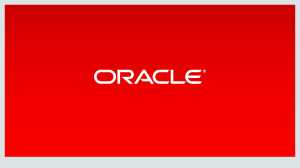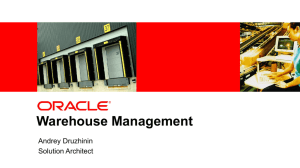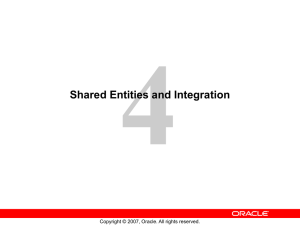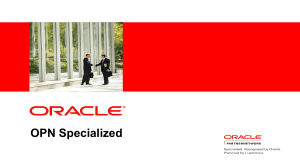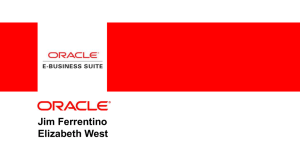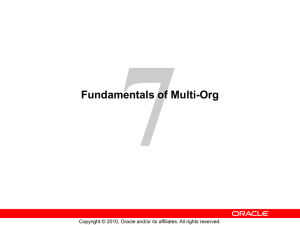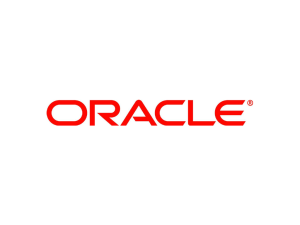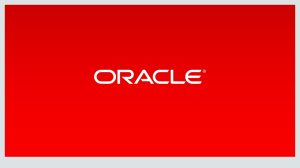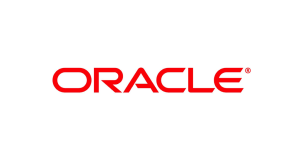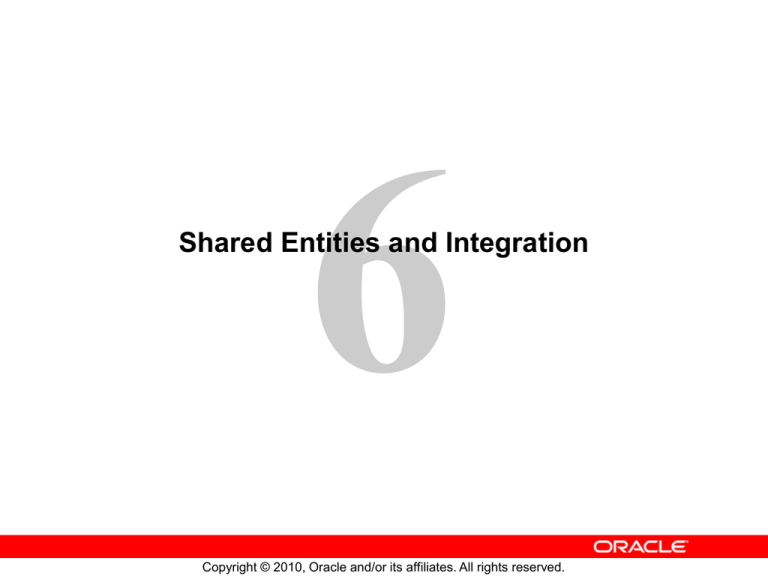
Shared Entities and Integration
Copyright © 2010, Oracle and/or its affiliates. All rights reserved.
Objectives
After completing this lesson, you should be able to recognize
the following:
• Shared entities within R12.x E-Business Suite
• The key integration points and business flows between
products in E-Business Suite (EBS)
6-2
Copyright © 2010, Oracle and/or its affiliates. All rights reserved.
What Are Shared Entities?
•
•
6-3
Shared entities in R12.x EBS enable one-time definition of
an object and the use of that object across several
products.
Shared entities are “owned” by a single product for table
purposes only.
Copyright © 2010, Oracle and/or its affiliates. All rights reserved.
Shared Entities in E-Business: Examples
6-4
Entity
Description
AOL
Application administration
Ledger
Accounting information records
Unit of Measure
Method of quantifying items
Items
Raw materials, finished goods, or services
Suppliers
Vendors you buy from
Customers
Buyers of the end product
Sales Force
Individuals credited with sales revenue
Banks
Institution for financial transactions
Employees
Personnel who perform assigned tasks
Locations
Business sites (addresses)
Organizations
Logical unit entities
Copyright © 2010, Oracle and/or its affiliates. All rights reserved.
Application Object Library (AOL)
AOL
Currencies
Languages
Site profile options
6-5
Users
Menus
Responsibilities
Copyright © 2010, Oracle and/or its affiliates. All rights reserved.
Ledger
Chart of Accounts
Calendar
Currency
Owned by General Ledger
6-6
Copyright © 2010, Oracle and/or its affiliates. All rights reserved.
Convention
Units of Measure
•
•
•
•
Length
Base Unit = 1 cm
1 m = 100 cm
1 km = 100,000 cm
Units of Measure are used by a variety of functions and
transactions to express the quantity and measurement of items.
Units of Measure
Responsibility: Inventory, Vision Operations (USA)
(N) Setup > Units of Measure
6-7
Copyright © 2010, Oracle and/or its affiliates. All rights reserved.
Items
You can define and control all items in an inventory. After the
items have been defined, they are assigned to organization.
Responsibility: Inventory, Vision Operations (USA)
(N) Items > Master Items
6-8
Copyright © 2010, Oracle and/or its affiliates. All rights reserved.
Suppliers
Suppliers are the individuals or companies from which you
procure goods and/or services.
Responsibility: Payables, Vision Operations (USA)
(N) Suppliers > Entry
6-9
Copyright © 2010, Oracle and/or its affiliates. All rights reserved.
Customers
Customers are buyers of the end products and/or services.
Responsibility: Receivables, Vision Operations (USA)
(N) Customers > Customers
6 - 10
Copyright © 2010, Oracle and/or its affiliates. All rights reserved.
Sales Force
Sales Force comprises individuals credited with sales revenue.
Responsibility: CRM Resource Manager, Vision Enterprises
(N) Maintain Resources > Resources
Responsibility: Order Management Super User, Vision Operations
(USA)
(N) Setup > Sales > Sales persons
6 - 11
Copyright © 2010, Oracle and/or its affiliates. All rights reserved.
Employees
Employees are individuals employed by the company to
perform certain tasks.
Responsibility: Human Resources, Vision Enterprises
(N) People > Enter and Maintain
6 - 12
Copyright © 2010, Oracle and/or its affiliates. All rights reserved.
Banks
Internal bank accounts are created in Cash Management and
are shared across modules with payment and receipt
transactions.
Responsibility: Cash Management, Vision Enterprises
(N) Setup > Banks > Banks
6 - 13
Copyright © 2010, Oracle and/or its affiliates. All rights reserved.
Locations
Locations are physical addresses that may represent your
company’s addresses or your customer’s addresses.
Responsibility: Human Resources, Vision Enterprises
(N) Work Structures > Location
6 - 14
Copyright © 2010, Oracle and/or its affiliates. All rights reserved.
Organizations
Organization is an entity designation used to partition data into
logical units.
Responsibility: Human Resources, Vision Enterprises
(N) Work Structures > Organization > Description
6 - 15
Copyright © 2010, Oracle and/or its affiliates. All rights reserved.
Key Business Flows
Plan
Source
Make
Concept to
Release
Forecast to
Plan *
Market
Sell
Campaign to
Order
Procure to
Pay *
Contract to
Renewal *
Click to
Order
Demand to
Build *
Order to
Cash *
Inventory to
Fulfillment
Plan to
Replenish *
Support
Request to
Resolution *
Back Office
Benefits to
Payroll
6 - 16
People to
Paycheck
Project to
Profit
Accounting to
Financial
Reports
Copyright © 2010, Oracle and/or its affiliates. All rights reserved.
Forecast to Plan
Demand planning
Order management
Forecasts
Constraint-based
optimization
Sales Order Info
ASCP
6 - 17
Copyright © 2010, Oracle and/or its affiliates. All rights reserved.
Procure to Pay
Inventory
Cash
Management
Inventory
Activity
Requisitions
Accruals
Purchasing/iProcurement
Accounting
Suppliers
Ledger
Banks
Payables/
iExpenses
6 - 18
Payables/ Expenses/ Payments
General Ledger
Copyright © 2010, Oracle and/or its affiliates. All rights reserved.
Demand to Build
Cost info
Requisitions
Purchasing/
iProcurement
Cost
Management
ASCP/MRP
Planned Order info
Requisitions
Material/Resource info
Supply/Demand
info
Capacity
UOMs
Inventory
WIP
BOM
Engineering BOM info
Items
Order Management
6 - 19
Copyright © 2010, Oracle and/or its affiliates. All rights reserved.
Engineering
Order to Cash
Inventory
activity
Ledger
General Ledger
Inventory
Cash
Management
UOMs
Banks
Receivables/
Revenue/
Receipts
Purchasing/
iProcurement
Inter org/
Shipments
Inventory
Transactions
Reqs
Invoices
Receivables
/iReceivables
6 - 20
Customers
Order
Management
Copyright © 2010, Oracle and/or its affiliates. All rights reserved.
Items
Contract to Renewal
Standard sales
contract
Sales Contracts
iStore
Standard sales
contract
Service Contracts
Quoting
Quote to booked
order
No item –
warranty
only
Service contract for
item with warranty
Invoice
Order Fulfillment
Order to Cash
6 - 21
Accounts
Receivable
Copyright © 2010, Oracle and/or its affiliates. All rights reserved.
Request to Resolution
Solutions
Customers
Knowledge
Management
Create SR
Merchant assistance
iSupport
Customer
Products
owned
Create RMA
Teleservice
Create return
order
Items
Inventory
6 - 22
Order Capture
Foundation
Items
APIs
Installed Base
Order
Fulfillment
(Order to Cash)
Copyright © 2010, Oracle and/or its affiliates. All rights reserved.
Plan to Replenish
Perform Min-Max Planning
Establish Inventory
Planning Policies
Purchasing
Inventory
Enterprise Roles
Plan Min-Max Material
Purchasing
Generate
Requisitions
Requisition to Receipt
Inventory
Manager
System
Inventory
Automated planner
Purchasing
6 - 23
Copyright © 2010, Oracle and/or its affiliates. All rights reserved.
Quiz
Oracle Inventory owns Units of Measure.
a. True
b. False
6 - 24
Copyright © 2010, Oracle and/or its affiliates. All rights reserved.
Quiz
Which module owns Internal Banks?
a. Cash Management
b. General Ledger
c. Payables
d. Receivable
6 - 25
Copyright © 2010, Oracle and/or its affiliates. All rights reserved.
Quiz
In the “Order to Cash” business cycle, details of shipping goods
and providing related services are entered in:
a. Purchasing
b. Receivables
c. Order Management
d. Inventory
6 - 26
Copyright © 2010, Oracle and/or its affiliates. All rights reserved.
Quiz
Three products are involved in the “Forecast to Plan” business
flow.
a. True
b. False
6 - 27
Copyright © 2010, Oracle and/or its affiliates. All rights reserved.
Summary
In this lesson, you should have learned about:
• The shared entities within R12.x E-Business Suite
• The key integration points and business flows between
products in R12.x E-Business Suite
6 - 28
Copyright © 2010, Oracle and/or its affiliates. All rights reserved.

